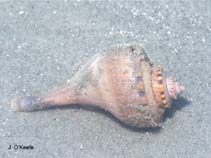Busycotypus canaliculatus (Linnaeus, 1758)
Channeled whelk| Native range | All suitable habitat | Point map | Year 2050 |

|
| This map was computer-generated and has not yet been reviewed. |
| Busycotypus canaliculatus AquaMaps Data sources: GBIF OBIS |
Classification / Names Common names | Synonyms | CoL | ITIS | WoRMS
| Neogastropoda | Melongenidae
Environment: milieu / climate zone / depth range / distribution range Écologie
; saumâtre; profondeur 0 - 114 m (Ref. 83435). Temperate; 42°N - 28°N, 81°W - 69°W (Ref. 83435)
Distribution Pays | Zones FAO | Écosystèmes | Occurrences | Introductions
Western Atlantic and Eastern Central Pacific: USA; from Cape Cod, Massachusetts to Cape Canaveral Florida (Ref. 101514). Introduced to San Francisco Bay, CA. Subtropical to temperate.
Length at first maturity / Taille / Poids / Âge
Maturity: Lm 15.5 range ? - ? cm Max length : 20.1 cm DL mâle / non sexé; (Ref. 83435)
Maximum depth from Ref. 104442. On intertidal flats and seaside lagoons (Ref. 104331). Inhabits sand and sand-mud bottoms, often entirely buried in sediments. Sometimes seen on mussel or oyster beds while foraging. Active at low light, mostly at night during summer months. Both an active predator and scavenger. Capable of readily detecting food in its vicinity (Ref. 101546) by sensing the water the prey pumps out (Ref. 105269). Primarily feeds on bivalves (Ref. 101546) such as mussels and oysters (Ref. 105269).
Life cycle and mating behavior Maturité | Reproduction | Frai | Œufs | Fécondité | Larves
Copulation is evident. Life cycle: Embryos develop into planktonic trocophore larvae and later into juvenile veligers before becoming fully grown adults (Ref. 833).
Référence principale
Références | Coordinateur | Collaborateurs
Bisby, F.A., M.A. Ruggiero, K.L. Wilson, M. Cachuela-Palacio, S.W. Kimani, Y.R. Roskov, A. Soulier-Perkins and J. van Hertum. 2005. (Ref. 19)
Statut dans la liste rouge de l'IUCN (Ref. 130435)
statut CITES (Ref. 108899)
Not Evaluated
CMS (Ref. 116361)
Not Evaluated
Menace pour l'homme
Utilisations par l'homme
Pêcheries: commercial
| FishSource |
Outils
Plus d'informations
Pays
Zones FAO
Écosystèmes
Occurrences
Introductions
Stocks
Écologie
Régime alimentaire
Éléments du régime alimentaire
Zones FAO
Écosystèmes
Occurrences
Introductions
Stocks
Écologie
Régime alimentaire
Éléments du régime alimentaire
Sources Internet
BHL | BOLD Systems | CISTI | DiscoverLife | FAO(Publication : search) | Fishipedia | GenBank (genome, nucleotide) | GloBI | Gomexsi | Google Books | Google Scholar | Google | PubMed | Arbre de Vie | Wikipedia (Go, chercher) | Zoological Record
Estimates based on models
Preferred temperature
(Ref. 115969): 8.5 - 24.6, mean 14.2 (based on 108 cells).
Catégorie de prix
(Ref. 80766):
Unknown.



